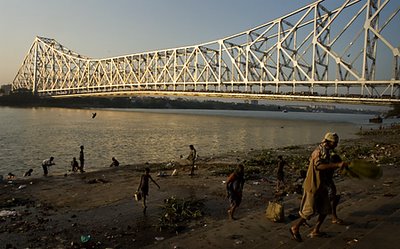
The waters of many of the rivers in this part of the world either start high up on Tibetan plateau or originate from the mighty Himalaya range. Eventually, as in nearly all rivers, the water finds its way to the sea. Along the way, it weathers the rock that it meets. And from this interaction, sand and silt are brought down to the plains. It is within these northern plains in the Indian subcontinent that one of the highest population densities in the world exists. And this is in part due to what the rivers bring here.
Even in the monsoon season, when the waters rise to
 “catastrophic” levels and humans experience disruption and destruction in their lives, the land breathes, it is once again nourished with the mineral silts that have washed down from the “abode of the gods”. And this is one of the main reasons so many people live here and have done so for thousands of years – the land is self-replenishing. It is one of the richest agricultural areas in the world. If land typically is able to support one or two crop harvests per year, here, the land can support three or four.
“catastrophic” levels and humans experience disruption and destruction in their lives, the land breathes, it is once again nourished with the mineral silts that have washed down from the “abode of the gods”. And this is one of the main reasons so many people live here and have done so for thousands of years – the land is self-replenishing. It is one of the richest agricultural areas in the world. If land typically is able to support one or two crop harvests per year, here, the land can support three or four.From California to Calcutta, from Mexico City to Madrid, from Santiago to Shanghai, populations have been increasing rapidly and as a result, land is becoming more scarce. Land once used only for agriculture is being developed for homes. Just as large animals need a range of land to exist, so does a river. And encroaching on either’s territory leads to conflict if one’s aim is to dominate the other. So many people are desperate now to just survive, to care of themselves and their families, they’ll risk living in these zones.
Rivers don’t aim to wreak havoc, they just do what they do. They breathe in and they breathe out. We can try to control this breath but sooner or later, a river will set itself free. Here in the northern plains of South Asia, the most important rivers are the Ganges (and Padma), the Brahmaputra (and Jamuna), the Indus, the Narmada, and the Yamuna. Over the next decade, I hope to help tell the stories of some of these waterways and of the relationships that people have with them.
In this part of the world, a river is held in a very different regard as it is in the West. While there is unfortunately little concern for what goes into many of the rivers here, the body of water has a soul and it is respected and prayed to as the embodiment of a god. And in such, since god occasionally (or regularly) punishes us mortals, the river is also feared and so it is not uncommon to see offerings being made, prayers being given to the river so “god” will protect those offering puja. It is the Hindus that cultivate these relationships while Muslims go to the mosque or make their prayers in the direction of their holy city, Mecca.

When I see and experience the relationship that people have with a river or the ocean, most of my western, scientific, skepticism is left elsewhere. Usually, I am taken aback by the devotion that people have. And there’s a part of me, that because it is a form of very personal devotion where they are not trying to convert me or make me wrong for some reason or another, that I am able to relate to this kind of relationship. While my own worship looks, smells, and seems different in many regards, I feel connection with some of the devotees out of shared reverence, respect, and gratefulness for this natural element and for the life that it gives.
The important rivers are also theatres of life and society. The intimate rituals of life and death take place along its shores. For thousands of years, people have been making pilgrimages to some of the same places along the rivers to make puja (prayer) and to bathe in its sacred waters. For the Hindus who do this, to die in Varanasi (which I hope to visit again on this trip) means being released from the endless cycle of rebirth, samsara. Not having to be reborn as a human again and experience all of the suffering that we humans endure is quite the motivator and so people from all over India will make their last pilgrimage to this city to wait out their final days.
The rivers in this part of the world hold a different place in the lives of the people who live along its shores and depend on it for their livelihoods. Rivers and the lives of its peoples all over the world are changing; I hope to shine a light on some of these experiences, some of these relationships, and some of unexplainable that only a great river can sing.

No comments:
Post a Comment